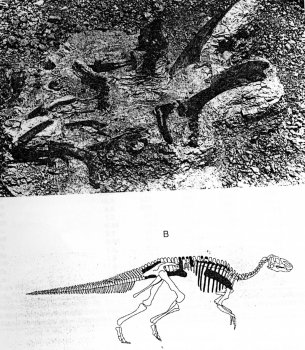La publicación tiene dos puntos de interés, por una parte demuestra la aplicabilidad del método de datación U-Pb para los huesos fósiles, por otra demuestra que los dinosaurios no avianos se encontraban en la parte baja del Terciario, y por tanto sobrevivieron como grupo al impacto. El camino que han abierto los investigadores es enorme, porque uno de los grandes problemas en los dinosaurios es poderlos datar de una manera adecuada sobre el mismo material fósil. En la mayoría de los casos esa datación se realiza de una manera indirecta o por correlación. Independientemente de los problemas metodológicos que pueda llevar la ausencia de plomo en los huesos, problemas de recristalización, diagénesis etc., estamos ansiosos si esta técnica se puede aplicar de manera global en los dinosaurios.
La referencia completa en: Fassett, J.E., Heaman, L.M., and A. Simonetti. 2011. Direct U-Pb dating of Cretaceous and Paleocene dinosaur bones, San Juan Basin, New Mexico. Geology 39:159-162. doi: 10.1130/G31466.1
El resumen es: Vertebrate fossils have been important for relative dating of terrestrial rocks for decades, but direct dating of these fossils has heretofore been unsuccessful. In this study we employ recent advances in laser ablation in situ U-Pb dating techniques to directly date two dinosaur fossils from the San Juan Basin of northwestern New Mexico and southwestern Colorado, United States. A Cretaceous dinosaur bone collected from just below the Cretaceous-Paleogene interface yielded a U-Pb date of 73.6 ± 0.9 Ma, in excellent agreement with a previously determined 40Ar/39Ar date of 73.04 ± 0.25 Ma for an ash bed near this site. The second dinosaur bone sample from Paleocene strata just above the Cretaceous-Paleogene interface yielded a Paleocene U-Pb date of 64.8 ± 0.9 Ma, consistent with palynologic, paleomagnetic, and fossil-mammal biochronologic data. This first successful direct dating of fossil vertebrate bone provides a new methodology with the potential to directly obtain accurate dates for any vertebrate fossil.
La referencia completa en: Fassett, J.E., Heaman, L.M., and A. Simonetti. 2011. Direct U-Pb dating of Cretaceous and Paleocene dinosaur bones, San Juan Basin, New Mexico. Geology 39:159-162. doi: 10.1130/G31466.1
El resumen es: Vertebrate fossils have been important for relative dating of terrestrial rocks for decades, but direct dating of these fossils has heretofore been unsuccessful. In this study we employ recent advances in laser ablation in situ U-Pb dating techniques to directly date two dinosaur fossils from the San Juan Basin of northwestern New Mexico and southwestern Colorado, United States. A Cretaceous dinosaur bone collected from just below the Cretaceous-Paleogene interface yielded a U-Pb date of 73.6 ± 0.9 Ma, in excellent agreement with a previously determined 40Ar/39Ar date of 73.04 ± 0.25 Ma for an ash bed near this site. The second dinosaur bone sample from Paleocene strata just above the Cretaceous-Paleogene interface yielded a Paleocene U-Pb date of 64.8 ± 0.9 Ma, consistent with palynologic, paleomagnetic, and fossil-mammal biochronologic data. This first successful direct dating of fossil vertebrate bone provides a new methodology with the potential to directly obtain accurate dates for any vertebrate fossil.
LUGAR Nuevo Méjico, EE.UU.



















